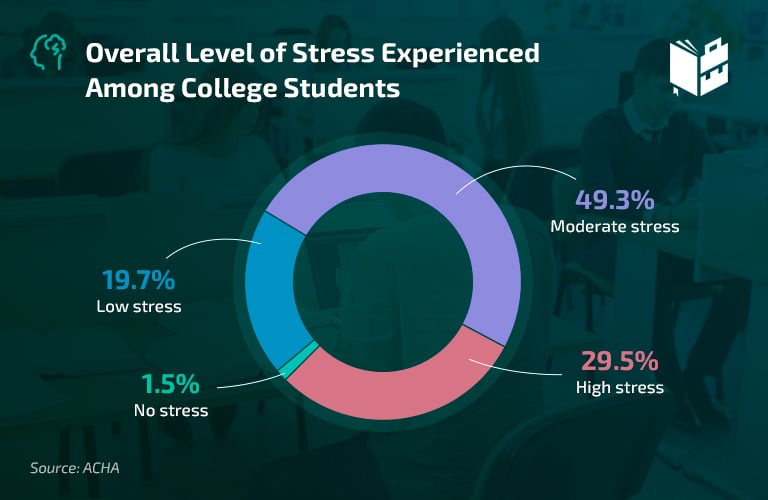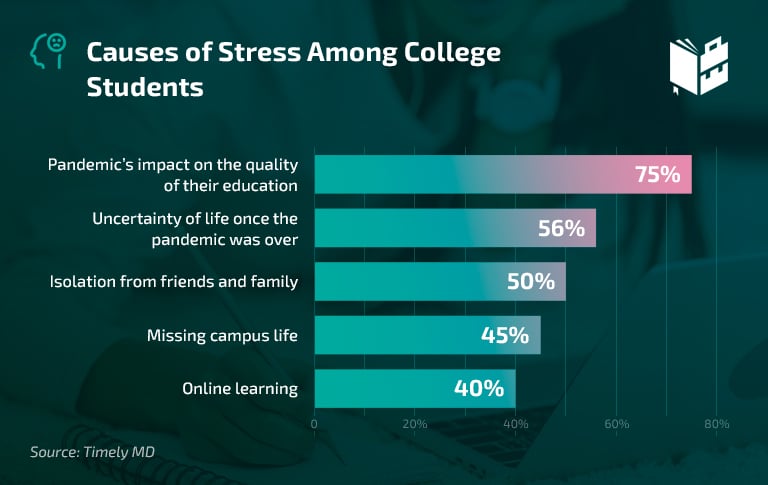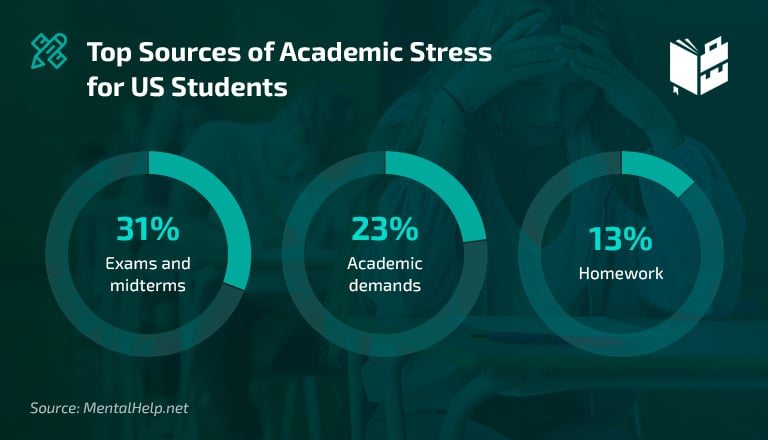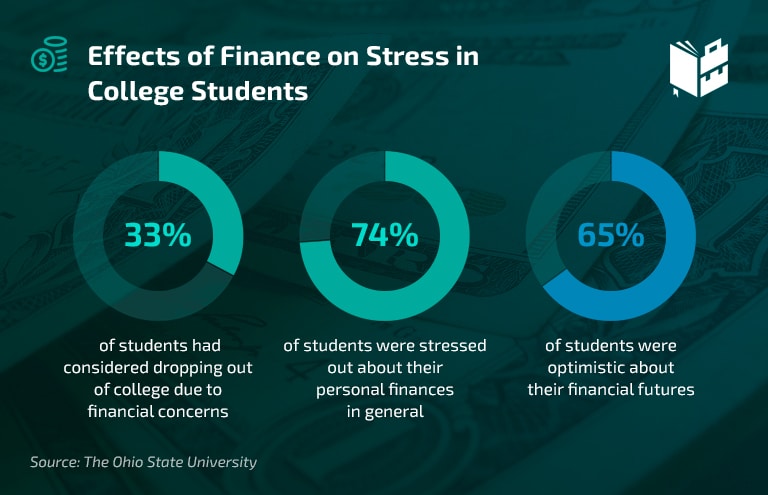According to recent college student stress statistics, students in the US are under a lot of pressure. Challenges, demands, and expectations pile up, threatening to impede academic success. No matter if it’s chronic, acute, or episodic, stress can quickly undermine the chances of receiving a diploma and influence other aspects of life.
Below, you can find the most important information that shows the increase of stress-related behavior in American students and its causes and impact on academic performance.
Facts and Stats on College Student Stress — Editor’s Choice
- 49.3% of college students experience moderate levels of stress.
- One year after the coronavirus outbreak, four out of five students are still stressed out.
- With 63%, video chats are the primary tool for students to cope with stress.
- 31% of students say exams and midterms are the most significant sources of stress.
- 64.5% of college students with relationship problems feel stressed because of them.
- 33% of college students think about leaving college because of financial problems.
- Financial problems are a source of stress for 74% of college students.
- 39.1% of US college students feel well-rested for only one or two days a week.
General Stress in College Students Statistics
1. 53% of US students neglect their social life because of stress.
(NYU)
More than half of college students in the US refuse to hang out with friends due to stress, which can impact their overall well-being. Moreover, adverse physical effects of stress include immune system suppression that can increase proneness to illnesses and psychological conditions such as anxiety and depression.
2. 49.3% of college students feel moderately stressed.
(ACHA)
College students’ stress statistics from the American College Health Association study show that almost half of the students in the US are experiencing moderate stress. Moreover, nearly a third (29.5%) endure high stress, while 19.7% report low stress levels.

3. 20% of students reported being stressed six or more times in the past year.
(Harvard Medical School)
Recent college students and stress statistics reveal 75% of students have gone through a stressful event in the past 12 months. Such a situation can cause setbacks in their academic progress and plenty of other mental issues.
4. 41.3% of students claim stress is the biggest reason for poor academic performance.
(ACHA)
Students usually feel pressure to get good grades. Unfortunately, this often affects their ability to focus during lectures or studying, ultimately leading to poor academic performance. Moreover, 35.1% listed anxiety as the main reason their academic performance suffered negatively.
Student Stress Statistics — COVID-19 Facts & Figures
5. 85% of college students experienced increased stress and anxiety during the COVID-19 pandemic.
(Timely MD)
Even more worrying is that, although 75% of students are willing to use telehealth to receive mental health care, only 21% have sought professional support via this technology and talked to a health professional or licensed counselor.
6. Four in five students reported feeling stressed in 2021.
(Timely MD)
For 75% of the respondents, the main stressor was the pandemic’s impact on the quality of their education. Additionally, 56% worried about the uncertainty of life once the pandemic was over. The main college stress driver for 50% of college students was the isolation from friends and family, and 45% were missing campus life. Finally, 40% stressed about online learning.

7. 76% of bachelor’s degree students say emotional stress is why they have considered withdrawing from college.
(Lumina Foundation)
The pandemic caused many changes in students’ lives, including transitioning to online learning and closing campuses. As a result, emotional stress levels in college students elevated due to the pandemic, with bachelor’s degree pursuers being stressed out the most. In addition, a somewhat smaller percentage of associate degree students (63%) claim they have weighed leaving college due to emotional stress.
8. With 63%, video chats are the primary tool for students to cope with stress.
(Timely MD)
A 2021 study on over 1,300 college students found that most of them video chat with friends and family to overcome stress, whereas 52% resort to phone calls. Additionally, 40% report watching TV/movies, and 38% have in-person time with friends.
9. 48% of students didn’t drink alcohol during COVID-19.
(College Pulse)
The increased stress among college students during the pandemic has resulted in decreased use of cannabis and alcohol. According to recent statistics, 62% of college students reduced or didn’t consume alcohol. Furthermore, 81% reported using less or no cannabis. On the other hand, 39% of students said they spent more time cooking, and 19% reported working out more.
10. According to college stress statistics, 77% of students haven’t used any support offered by the college to deal with stress.
(College Pulse)
Recent survey results reveal that over three-quarters of students experiencing increased stress levels haven’t sought support from their college (telehealth, support groups, or counseling). Instead, students are more likely to find emotional support in friends (64%), parents (45%), and their partners (30%).
Common Sources of Negative Stress Among College Students
11. 31% of students say exams and midterms are the most significant sources of stress.
(MentalHelp.net)
After enrolling in a college, a lot of coursework and homework becomes the norm. Yet, not all students are capable of dealing with immense pressure. As a matter of fact, almost a third say academic demands are the top stressors for a college student. Classes and workload are the third major source of stress with 23%, while homework places fourth with 13%.

12. 24% of students in the United States stress about their future and finding a job after graduation.
(MentalHelp.net)
According to stress in college students statistics, almost a quarter of young adults at universities fear not being able to land a job in their respective fields. Even though the US economy is stable and experts are optimistic about the decline of unemployment, college students are worried about entering the job market. Alternatively, they are concerned about not managing to support themselves or their families.
13. College student stress statistics indicate that 69% of first-year students feel severe forms of homesickness.
(HAP)
Separation from their loved ones causes a spike in stress levels. According to recent data, about 30% of US college students feel homesick. This issue is greater for first-year students, with more than two thirds of them reporting severe forms of homesickness.
14. 64.5% of college students who have problems with intimate relationships experience moderate or high stress.
(ACHA)
It comes as no surprise that college students and stress are related. When emotionally involved in a relationship, breakups can be a highly traumatic experience and can even take a toll on one’s mental health. Recent statistics reveal that 37.9% of students in the US find it challenging to balance their studies with their relationships. Moreover, more than 60% who have these problems experience moderate or high stress levels.
Financial-Related Causes of Stress in College Students
15. 33% of college students consider dropping out of college because of financial constraints.
(The Ohio State University)
An Ohio State University study conducted on 24,884 college students from 60 institutions across the US shows that a third of college students think about leaving college due to financial problems. Moreover, 45% say they’re unlikely to come up with $400 for financial emergencies during the school year.

16. 74% of students stress about their financial situation.
(The Ohio State University)
It seems that younger generations are also heavily affected by stress related to their financial situation. According to statistics on stress in college students, almost 75% of college students are stressed about their financial affairs. The study encompassed various profiles of students, including those at two-year and four-year private colleges and public institutions.
17. 43% of full-time undergraduate students take up jobs to put themselves through college.
(NCES)
As if demanding college coursework weren’t stressful enough, plenty of students in the US have to work to support themselves through college. On top of that, college student stress statistics indicate that 27% of full-time students have to work 20 or more hours per week. This affects their schedule, reducing the available time for their academic pursuits and increasing their stress levels.
18. 53% of students turn to loans as a way of financing their studies.
(The Ohio State University)
Another element that adds to the overall feeling of stress and anxiety is that more than half of college students are in debt. Paying the installments in time causes stress among college students, harming their academic success. Students need the money to fund tuition, housing, and even books and learning materials.
19. 34.3% of students neglect their studies because of the money they owe.
(The Ohio State University, Student Loan Hero)
The extent to which debt and financial uncertainty cause stress is astonishing. Currently, the total student loan debt in America is estimated at nearly $1.75 trillion, while the average loan debt of students who graduate was estimated to be around $28,400.
Health-Related Causes of College Stress Statistics
20. 29.5% of students say medical problems affect their grades.
(ACHA)
It can be hard to study and keep up with coursework when you are feeling under the weather. The range of diseases affecting students includes respiratory illnesses (13.3%), flu (4.5%) and stomach problems (3.6%).
21. 39.1% of college students in the US report feeling well-rested for only one or two days a week.
(ACHA)
The results of a recent study on stress among college students reveal that less than half of students take enough rest: almost 40% of them feel rested for only one or two days, while 19.5% say they don’t feel rested throughout the whole week.
In fact, only 9% of students sleep well at night, while 32.4% say they feel rested between three and five days a week. This stress-related burnout can have a tremendous impact on their academic performance.
Student Stress Statistics — The Impact of Excessive Stress
Known as our “fight or flight” response, stress is an instinctive reaction that can be either positive or negative. When it comes to the positive aspects of stress in college, students can improve their productivity when they’re under pressure. Nonetheless, the negative aspects of stress often outweigh the positive ones.
Various symptoms can appear due to being under prolonged exposure to stressful situations, including hypertension, headache, or lack of concentration. Excessive stress can impact students’ mental health and even lead to suicidal thoughts. Therefore, it’s essential to recognize the most significant stressors, develop proper coping mechanisms to deal with anxiety and stress, and ask for help if needed.